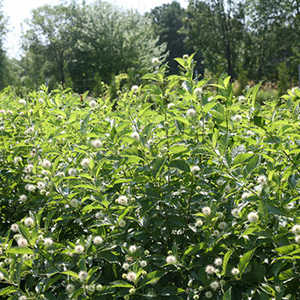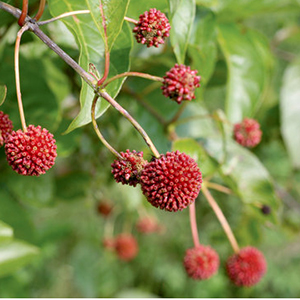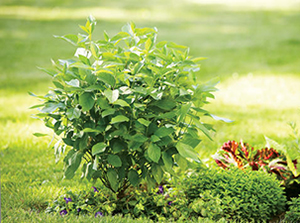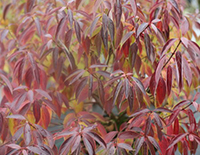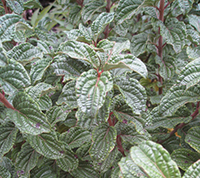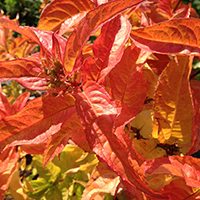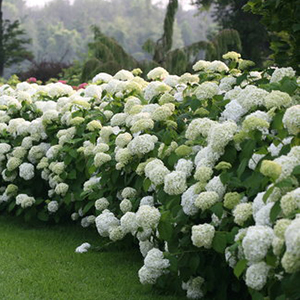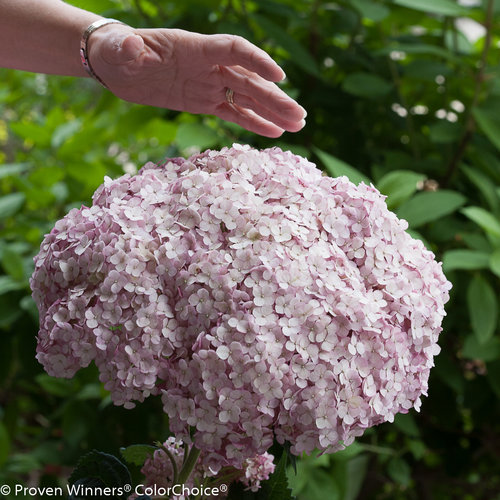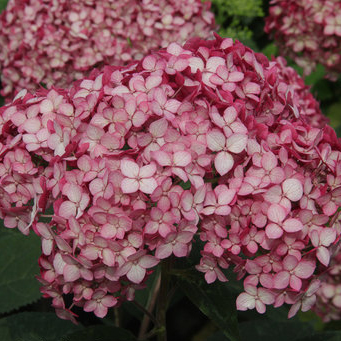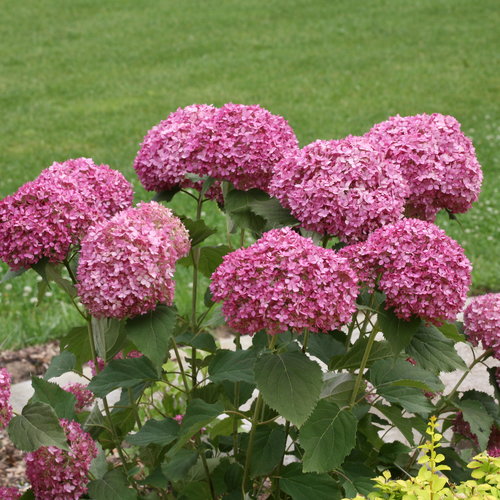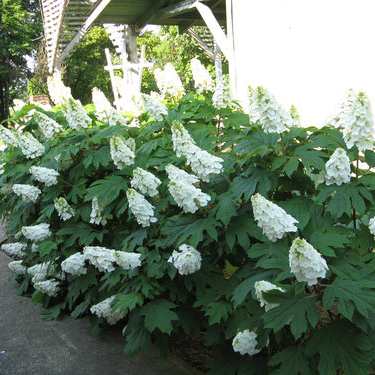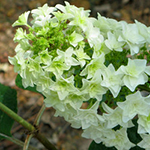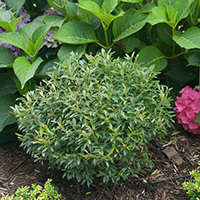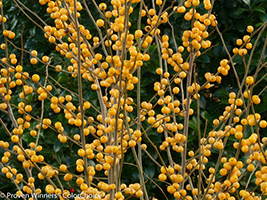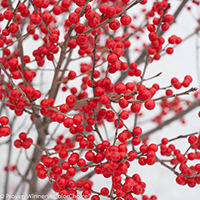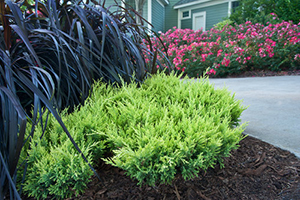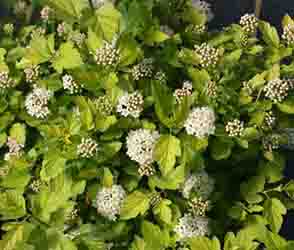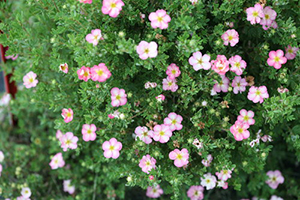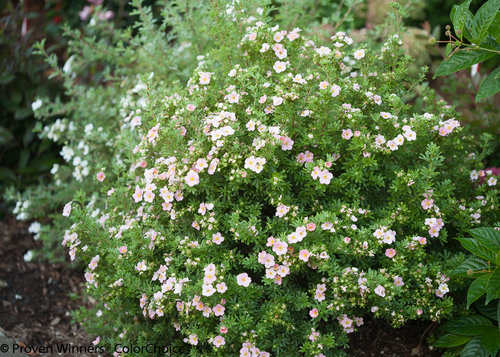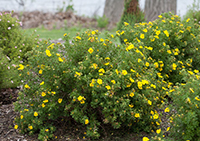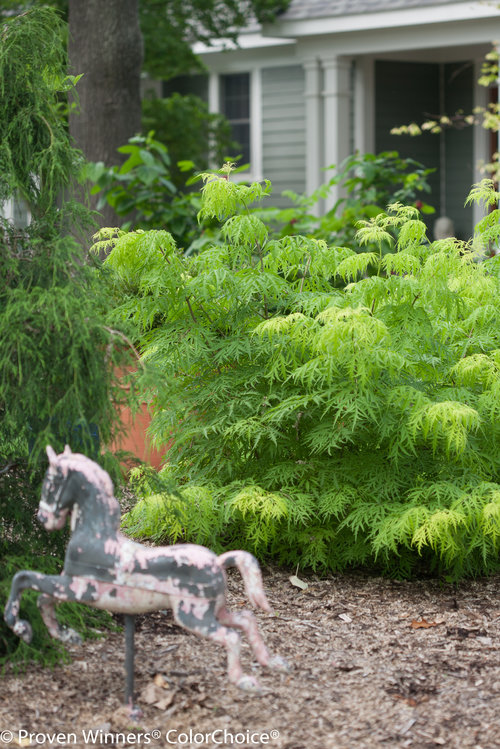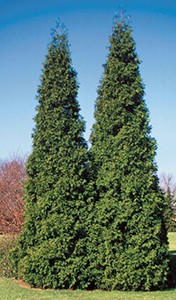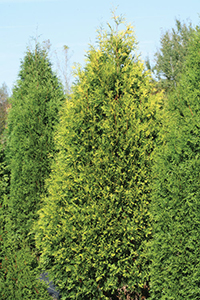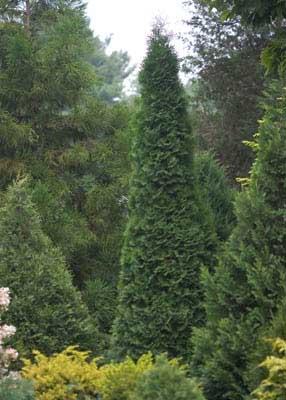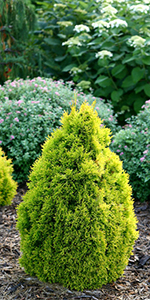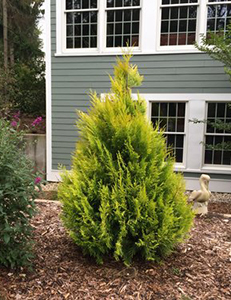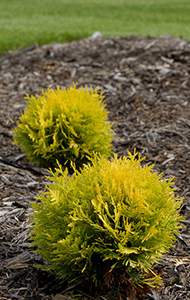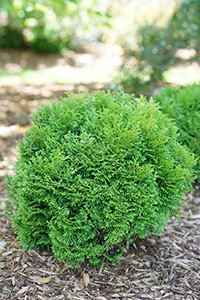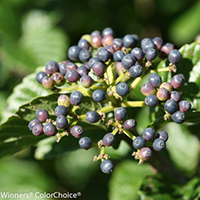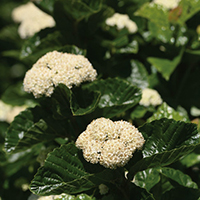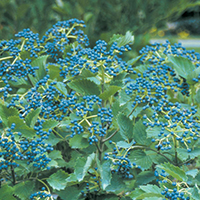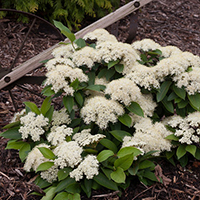An In-Depth Look at Proven Winners Native Shrubs
Native cultivars make up a large part of our native flowering shrubs catalog, from Aronia to Viburnum. Take an in-depth look at all of them in this comprehensive article featuring our best native shrubs.
If you think that planting native shrubs will make your yard look dull, weedy, and unkempt, think again! North America hosts a staggering diversity of native plants to bring structure, beauty, and year-round interest to your landscape. Native plants create a hospitable environment for wildlife, including birds and butterflies, and bring an effortless, natural look to your plantings. You may have native plants in your landscape already and not even realize it.
Whether you want to learn more about what you are already growing or are planning to add something new, we’ve developed this comprehensive list of our best shrubs for North American gardens and native shrub cultivars for your reference.
Also known as chokeberry due to its edible but extremely astringent fruits, aronia (Aronia melanocarpa) occurs naturally throughout the entire eastern half of the US and Canada. It is the perfect example of a native plant that’s also a garden workhorse: in spring, hundreds of white flowers burst open, revealing bright pink pollen. Throughout summer, deep purple-black fruit develops, which contrasts with the outstanding red-orange-yellow fall color. Not only is it a true multi-season plant, it’s one of the most all-around-tough, low maintenance shrubs you’ll find. Shade, sun, wet soil, dry soil, salt: it can take it all. In the wild, aronia grows as a large shrub or small tree, which means conventional varieties take up a quite a bit of room. Low Scape® Mound and Low Scape® Hedger aronia, however, offer unique, space-saving habits that open up entirely new possibilities for this species. Low Scape® Mound naturally grows as a tidy mound, perfectly suited to groundcover and edging beds. Low Scape® Hedger aronia grows as a narrow column, which works well for foundation plantings and low hedges. Both are hardy to USDA zone 3 and heat tolerant into USDA zone 9, so nearly everyone in North America can enjoy these durable, beautiful native shrubs. |
The flowers of buttonbush (Cephalanthus occidentalis) look so unusual, it’s hard to believe that this shrub is native to well over half of North America. But you can enjoy these amazing blooms in your own yard, year after year, along with their outstanding fragrance, when you plant Sugar Shack® buttonbush. This variety was developed from wild specimens with the goal of creating a smaller, more landscape-friendly plant that works with any sized home and property. When the blooms fade, the resulting fruit turns bright red to extend the season of interest by several weeks. |
That red-twig dogwood (Cornus stolonifera) is so ubiquitous in the wild says a lot about the durability of this popular native shrub. Though its white flower clusters in late spring are a nice touch, it doesn’t really stand out until autumn. That’s when, as if by magic, the stems turn vivid red. This becomes even more dramatic when the leaves drop, and the color persists clear through spring. Tolerant of just about any soil and light level, probably the biggest liability for red-twig dogwood was its large size. Our Arctic Fire® red-twig dogwood solves that by staying at a relatively petite 3-5’ height and width. |
Diervilla may not be the showiest plant in your landscape, but it exudes a handsome ruggedness and unflappable tolerance for difficult conditions that will make you grateful you planted it. Native to a huge swath of North America, it has neat and tidy foliage, yellow flowers all summer long, and vigorous growth. We selected the three members of our Kodiak® series of diervilla for their colorful foliage. When the new growth emerges (especially in spring) and in fall, they really come alive in the landscape. Take your pick of red, orange, or black for a specimen, hedge, or just general landscaping uses. Kodiak® Orange diervilla is an especially nice native alternative to burning bush. |
Hydrangeas are the queen of the summer landscape, and North America boasts two eminently garden-worthy species: Hydrangea arborescens and Hydrangea quercifolia. Smooth hydrangea, often called Annabelle hydrangea, is known botanically as Hydrangea arborescens. It is native from New York to Florida and west to Oklahoma. It is super cold hardy down to USDA zone 3 but also tolerant of heat and humidity. Its ability to thrive in so many places, combined with its showy blooms, explains its popularity. Incrediball®, an improved ‘Annabelle’-type with stronger stems and larger flowers, is one of our best sellers. We also offer four pink varieties – Incrediball® Blush, Invincibelle® Spirit II, Invincibelle® Ruby, and Invincibelle Mini Mauvette®. These four all contain the parentage of a single pink-flowering H. arborescens found growing in the wild in the Blue Ridge Mountains by a horticulture graduate student on a hike. Oakleaf hydrangea (Hydrangea quercifolia) is beloved by plant geeks and designers. Not only is it native throughout the American South, it’s a true four-season beauty. In spring, large oak-shaped leaves emerge, each covered in thick white hairs. Summer brings huge white flower clusters with honey-like fragrance. Then, it really comes into its own in autumn when the leaves turn red and burgundy, creating one of the most spectacular displays of any hydrangea, period. The foliage drops to reveal a dramatic silhouette and beautiful cinnamon-colored peeling bark. Oakleaf hydrangeas are the most shade tolerant of all hydrangeas. They are hardy too, blooming reliably down to USDA zone 5. Our Gatsby™ series of oakleaf hydrangeas runs the gamut from semi-dwarf (Gatsby Gal®) to double blooms (Gatsby Star®) to flowers that age to pink (Gatsby Pink®). |
The common name holly refers to a diverse group of plants that are native to places all over North America, from the chilly north to the steamy south. Our native species are a little bit different than what most people think of when they hear the name “holly,” but they are fantastic landscape plants that you might consider growing for their beauty, usefulness and native parentage. The black berries of inkberry holly, Ilex glabra, were once used as an ink substitute during the Civil War. While they are a nice feature, the main reason people grow inkberry holly now is its lustrous evergreen foliage and neat habit. We introduced Gem Box® inkberry holly as a substitute for boxwood since it looks similar and can be used in much the same way, with the added advantages of resistance to disease and winter damage. Whether you grow it as a hedge, specimen, or edging plant, it’s a good native option to consider for both formal and informal landscapes. Winterberry holly, Ilex verticillata, has an enormous native range: over half of North America lives in a state or province where it grows naturally. You may not recognize it as a holly if you happened across it, since most people think of hollies as evergreen and this one is a deciduous holly that loses its leaves each autumn. Losing its leaves gives a better view of its bright red berries that appear from fall into winter. Winterberry holly is a very tough plant, tolerating both hot and cold climates, wet and dry soils, and sun or shade. Our extensive offerings include Berry Heavy® Gold which produces novel bright yellow berries, and dwarf varieties like Berry Poppins® which tame this typically large plant into one that is much easier to fit into residential landscapes. |
We’ve been offering Little Henry® sweetspire (Itea virginica) for decades, and it’s still one of our best sellers. Like the naturally occurring Virginia sweetspire, it has deliciously fragrant white flower spikes in early summer and some of the best fall foliage color in the entire plant kingdom. However, unlike its wilder cousin, Little Henry sweetspire has a low-growing mounded habit, so it is a better-behaved option for small spaces and gardens. We think it’s one of the best summer native flowering shrubs for shaded conditions in zones 5-8, and it’s deer resistant, too. |
North America is host to at least nine different species of juniper, which can be found growing native in nearly all 50 states and all 10 Canadian provinces. The rugged good looks, durable nature, and widely varied habits of this sometimes prickly evergreen have made it a popular landscaping plant. Good Vibrations® Gold is a selection of our native creeping juniper (Juniperus horizontalis) that is hardy in zones 3-9. It makes a superior groundcover thanks to its glowing gold color and soft-to the-touch foliage. Juniper loves the sun, and dry soils, and is typically quite resistant to deer, so it’s a very useful evergreen to have in your plant palette. |
From a garden standpoint, ninebark (Physocarpus opulifolius) is a relative newcomer, but this list of the best shrubs for North American gardens has been right under our noses all along. The introduction of colorful varieties of native flowering shrubs like Summer Wine®, Ginger Wine™, and Tiny Wine® Gold ninebark have made landscapers and homeowners take notice. This rose relative becomes covered in white flower clusters in late spring, while the colorful foliage provides interest throughout the entire growing season. |
If we told you there was a shrub that loves the cold, that deer never touch, and that blooms non-stop from spring through frost, would you want one for your garden? Meet potentilla, also known as shrub cinquefoil. Though some may write off this flowering shrub as too commonplace, the Happy Face® series was specially selected for their extra-large, extra-colorful blooms. Take your pick of three colors: cheery Happy Face® Yellow, crisp and clean Happy Face® White, or strawberry-toned Happy Face® Pink Paradise and start reaping the benefits of this effortlessly easy native shrub this season. |
When you plant an elderberry, you plant history. These plants are surrounded by myth and fable. North America is home to two economically and ornamentally important elderberry species: the summer blooming American elderberry (Sambucus canadensis) and early spring blooming red elderberry (Sambucus racemosa). |
Lemony Lace® is one of our most popular elderberries. Finely dissected, bright gold foliage makes this shrub a bold choice for planting as a specimen, hedge, or backdrop. It can be grown as a large shrub or small tree, depending on your preference. Thanks to its exceptional winter hardiness, even gardeners in USDA zone 3 can enjoy its deceptively exotic good looks of the best shrubs for North American gardens. |
If the only spirea you are familiar with is Japanese spirea, it’s time you get to know our utterly charming native birch leaf spirea, Glow Girl® Spiraea betulifolia. Her neat little birch-shaped leaves, mounded habit, and sweet spring flowers make her perfectly suited to any style of home or landscape in sun or part shade. She brightens her surroundings with her yellow foliage in spring and summer, and dazzles in fall with brilliant orange tones. Glow Girl spirea has a broad hardiness range from zones 3-9 and is deer resistant. |
You’ll find arborvitae growing pretty much everywhere. Local gas stations, mall parking lots, and fast food restaurants all seem to have at least one. They are the most popular evergreen Proven Winner native shrubs for planting as a living fence or privacy hedge. Did you know they are native? The eastern half of North America hosts eastern arborvitae, Thuja occidentalis, and the western half hosts western arborvitae, Thuja plicata, so whichever side of the country you are on, there’s a native arborvitae for you. Plant North Pole® as a striking specimen or space-saving hedge, Anna’s Magic Ball®, a cute little golden ball for tucking into a special spot, or Spring Grove®, a tall variety that makes a quick screen or wind block. |
With handsome foliage, stately habits, and showy flowers, viburnums are a connoisseur’s choice for sophisticated landscape designs. And since they are tolerant of shade and generally resistant to deer, they’re also excellent problem solvers for low maintenance shrubs. While the showiest viburnums are typically native to China or Japan, North America lays claim to some pretty amazing species too, like Brandywine™ viburnum (V. nudum), with its amazing display of ivory, pink, and blue berries, and its closely related cousin Lil’ Ditty® viburnum (V. cassinoides) which is one of few dwarf varieties available. Also worthy of consideration for a hedge, specimen, or any place you’d like to attract wildlife is arrowwood viburnum, Viburnum dentatum. All That Glitters® and All That Glows® boast incredibly glossy foliage, fluffy white flower clusters, and copious amounts of deep blue berries in fall and winter, thanks to their ability to pollinate one another. |
Our native shrubs offerings grow each year to meet the needs of gardeners and landscapers in a broad range of climates. If you’re having trouble finding the varieties that you want to buy locally, visit your favorite garden center and ask if they can order them in for you from a grower who supplies them with Proven Winners low maintenance shrubs. If you can’t find what you are looking for locally, shop our online store.






